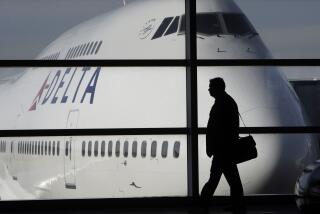NASA Linking Short Circuit to Delta Failure
- Share via
KENNEDY SPACE CENTER, Fla. — An electrical short circuit may have caused the loss of main-engine power that sent an unmanned Delta rocket with a $57.5-million weather satellite cartwheeling out of control just 71 seconds after blastoff, the head of NASA’s Delta program said Monday.
William Russell, Delta project manager from the Goddard Space Flight Center in Maryland, said an analysis of data from Saturday’s ill-fated launching reveals two “large amplitude spikes” that could have set off a split-second chain of events leading to the premature engine shutdown.
“We feel this is quite a significant find,” Russell said at a news conference here. But he cautioned that “you don’t jump to conclusions. . . . This just begins the investigation.”
Russell appeared at the news conference with Lawrence J. Ross, director of spaceflight systems at NASA’s Lewis Research Center in Cleveland, who heads the eight-member board appointed Sunday to investigate the Delta disaster.
The failure of the $30-million Delta, the usually reliable “workhorse” of the space agency’s rocket fleet, followed the explosion of an unmanned Titan 34D rocket at Vandenberg Air Force Base in California on April 18 and the loss of the space shuttle Challenger with seven crew members on Jan. 28.
The string of accidents has shaken public confidence in the nation’s space program and led to much soul-searching at the National Aeronautics and Space Administration.
Launches Postponed
Ross, who arrived in Cape Canaveral on Sunday to begin laying the groundwork for his board’s investigation, said that the three remaining Delta launches--two scheduled for this year and one in late 1987--will be postponed until the cause of the latest Delta accident is uncovered.
He said there is also a “fair probability” that the scheduled launching of an Atlas-Centaur rocket with a Navy communications satellite on May 22 will be delayed “unless we stumble on the answer very, very quickly.”
He pointed out that the main engines in the Delta and Atlas-Centaur rockets are both manufactured by the Rocketdyne division of Rockwell International Corp. in Canoga Park, Calif.
Saturday’s launching of the 116-foot, three-stage Delta rocket appeared normal until the main liquid-fueled engine abruptly and mysteriously shut down 71 seconds after liftoff, throwing the vehicle into a wild tumble that tore off the nose and ripped out the weather satellite. Twenty seconds later, Air Force range safety officers sent a destruct signal to destroy the rocket.
Weather Monitoring Set Back
The destruction of the satellite sets back the government’s effort to monitor weather conditions, particularly in the hurricane spawning regions of the Atlantic Ocean. In Los Angeles, a spokesman for Hughes Aircraft Co., which builds the weather satellites, said the National Oceanic and Atmospheric Administration formally asked the company Monday to explore the feasibility of speeding up the construction of new satellites. The spokesman said Hughes officials are trying to determine if they could honor the request.
Russell, who has been poring over reams of computer data since the disaster, told reporters Monday that printouts show the presence of two distinct electrical current surges in the main-engine batteries, one following another less than a second before the engine shut down.
Voltage Drain Cited
The power surges, which appear as sharp spikes on the printouts, could have drained enough voltage from the batteries to cause a break in the electrical relays that keep the main engine fuel valves open, Russell said.
“It’s the first thing that leaps out from the data,” Ross said.
However, he added, the investigation would cover a broad range of potential causes, including the possibility of defects in the manufacturing of the rocket components and shortfalls in prelaunch procedures.
Sabotage Discounted
Ross also discounted speculation that the rocket failure may have been the work of saboteurs sending a destruct signal to the space vehicle as it rose into the sky off the Florida coast.
“I’m a little worried about somebody latching onto this as a serious contender for the source of the problem,” he said. “There’s absolutely no indication that the range (safety officer) or anybody else sent a signal to those receivers.”
Russell, however, said that the possibility of sabotage had not been “totally ruled out,” although at this point “it doesn’t look like” the work of saboteurs. “We’re looking at both here and at Huntington Beach (where the rockets are assembled to see) if you wanted to sabotage one, how would you,” he said.
The investigative panel headed by Ross will hold its first formal meeting on Thursday at Cape Canaveral. It is to present its findings by July 2 to Rear Adm. Richard H. Truly, NASA’s associate administrator for spaceflight.
Shepard Flight Honored
Earlier in the day, hundreds of NASA veterans gathered at Cape Canaveral Air Force Station to commemorate the 25th anniversary of astronaut Alan B. Shepard’s suborbital flight--the first time an American was put into space.
The silver anniversary celebration was tarnished by the string of disasters this year but the guest speakers had an upbeat message.
“It’s rare to win without some losses,” said Robert L. Crippen, who has flown on more space shuttle missions than any other astronaut. “There are few highs without some lows. That’s life. We certainly are in a low in the space program, but this too shall pass.”
More to Read
Sign up for Essential California
The most important California stories and recommendations in your inbox every morning.
You may occasionally receive promotional content from the Los Angeles Times.










